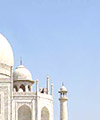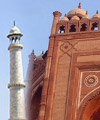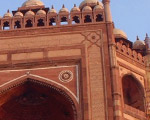 |
 |
 |
 |
 |
 |
 |
||
|
Agra
Agra is globally renown as the city of the Taj Mahal But this royal Mughal city has, in addition to the legendary Taj, many monuments that emphasis the high point of Mughal architecture. Once the capital of India under the Mughals, Agra is full of magnificent monuments dating back to the 16th and 17th century. It was here that the founder of the dynasty, Babar, laid out the first formal Persian garden on the banks of the river Yamuna. Here, Akbar, his grandson raised the towering ramparts of the great Red Fort. Within its walls, Jehangir built rose-red palaces, courts and gardens, and Shahajahan embellished it with marble mosques, palaces and pavilions of gem-inlaid white marble. The crowning glory of the city is obviously the Taj, a monument of love and imagination, that represents India to the world. Excursion Agra
Fort The Itmad-ud-daulah tomb stands in the centre of a grand Persian garden, an architectural gem of its times. It is the tomb of Mirza Ghiyas Beg, Emperor Jehangir's wazir, or Chief Minister, and also his father - in- law. The structure was built by Empress Noorjehan, between 1622 and 1628 and is very similar to the tomb she constructed for her husband, near Lahore in Pakistan. This splendid garden tomb is believed to be the precursor of the magnificent Taj Mahal, and was the first Mughal structure to be built entirely of marble, and the first, again, to make use of pietra dura, the inlay marble work that came to be typical of the Taj. Near the Agra Fort, is Jami Masjid, built by Shahjahan in 1648. An inscription over its main entrance indicates that it was built in the name of Jahanara, the emperor's daughter, who was imprisoned with the emperor by Aurangzeb. Around
Agra 40 km west of Agra, is the perfectly preserved 'phantom city' of Fatehpur Sikri. Between 1570 and 1586, during Akbar's reign, the city served as the capital of the Mughal empire, and was then abruptly abandoned probably due to lack of water supply. Today, albeit deserted, the city's palaces, courts and other monuments stand in mute testimony to the greatness, and amazing vision of the greatest emperor of all times, who was also a fine human being. The dargah or tomb of Sheikh Salim Chisti, the renowned saint, set in the courtyard of the Royal Mosque, still draws hordes of pilgrims who come to have their wishes fulfilled. Legend has is that the city was built by Akbar as a tribute to Sheikh Salim Chisti who foretold that he would have three sons.
55 kilometres from Agra is Bharatpur, which has an early 18th century Rajput Fort, but is better known, today, for one of the finest bird sanctuaries in the world. What was once the private hunting and shooting preserve of the Maharaja of Bharatpur is now a bird sanctuary called Keoladeo Ghana, sprawled over to 40 sq. kms of Swampy light-wooded terrain. Today, it is the protected breeding ground of hundreds of species of birds and home to migratory birds, especially the Siberian Crane, that spend their winters here. Other places to visit include, Mathura and Brindavan. Mathura, on the banks of the river Yamuna, is the birthplace of Krishna, and Brindavan, the land of thousands of shrines and temples, which still echoes with stories and songs that recount the exploits of this charming God. Getting There By Rail By Road Summer- Max.45, Min.21.9 Rainfall: 66 cms (June to September) Best Season: October to March
|
|||||||||
|
|||||||||
|
|||||||||
|---|---|---|---|---|---|---|---|---|---|